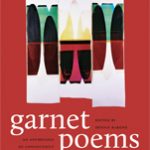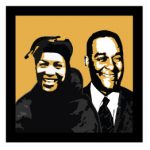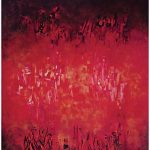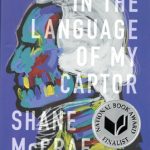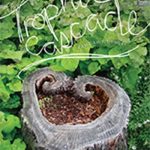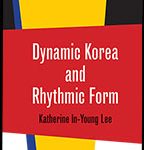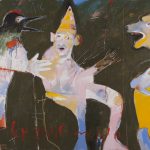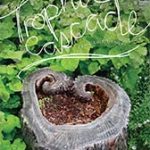From the novel Native Tributes, by Gerald Vizenor:
Dummy Trout surprised me that spring afternoon at the Blue Ravens Exhibition. She raised two brazen hand puppets, the seductive Ice Woman on one hand, and the wily Niinag Trickster on the other, and with jerky gestures the rough and ready puppets roused the native stories of winter enticements and erotic teases.
The puppets distracted the spectators at the exhibition of abstract watercolors and sidetracked the portrayals of native veterans and blue ravens mounted at the Ogema Train Station on the White Earth Reservation. The station agent provided the platform for the exhibition, and winced at the mere sight of the hand puppets. He shunned the crude wooden creatures and praised the scenes of fractured soldiers and blue ravens, an original native style of totemic fauvism by Aloysius Hudon Beaulieu.
The puppets were a trace of trickster stories.
Dummy was clever and braved desire and mockery as a mute for more than thirty years with the ironic motion of hand puppets. Miraculously she survived a firestorm on her eighteenth birthday, walked in uneven circles for three days, mimed the moods of heartache, and never voiced another name, word, or song. She grieved, teased, and snickered forever in silence. Nookaa, her only lover, and hundreds of other natives were burned to white ashes and forgotten in the history of the Great Hinckley Fire of 1894.
Dummy stowed a fistful of ash in a Mason jar.

We recently asked Gerald Vizenor, author of , to tell us a little more about his interest in hand puppets and why he used puppets so prominently in this latest book. This was his response.
Some people gesture with their hands and fingers as they speak, and these people are the hand talkers. I am fascinated by the hand gestures of direction, or scenes in stories. They pinch words, praise words, smooth, and reverse words with the turn of a finger. Some of my relatives were hand talkers, and the gestures are not the same but remind me of the moves of hand puppets. My first interest in hand puppets started with native dolls in museums, made of straw and cloth, and the stories that went along with the figures.
Later, as a soldier in Japan, I was inspired with the great Bunraku puppets. These puppets were visionary, transformation characters in traditional scenes, and the puppets created an incredible sense of presence through gestures, sound and story. The Bunraku puppets are not controlled with strings, but with the hands of a master, and the gestures and costumes are elaborate and traditional. The string and hand puppets are more common around the world, especially in Europe, and some puppet moves are more innovative than others. The Guignol is a famous hand puppet in France.
I am interested in any manner or style of puppets, the creative motion of fingers and figures to convey emotion, and convince the audience that there is a spiritual association between humans and puppets, something similar to a totemic association. Puppets are not the mere imitation of human gestures, but rather the spiritual motion, or natural motion that creates a sense of presence.
Laura Hall, my wife, and I twice attended an international puppet festival that is held every other year in France. The brilliant imagination of amateurs and master puppeteers from around the world create great puppet shows at the Festival Mondial des Théâtres de Marionnettes in Charleville-Mézières, France. My interest in puppets took another turn with the appreciation of the flea market hand puppets made with found objects, buttons, thimbles, plastics, tin cans, brushes, and bones. I was moved by the creative power of the hand puppets made with discarded material by the Paul Klee, the expressionist and surrealist artist. He created marvelous hand puppet creatures to amuse his son, but not as works of art.
Dummy Trout, the silent puppeteer in two of my recent historical novels, was an actual native person, and she was a marvelous hand talker. Her facial expressions and hand gestures almost created the sense of a puppet. Dummy, a wicked nickname because she apparently spoke a very early version of either Cree or the Anishinaabe language, and natives teased the manner of her speech since they did not understand the words. The only real dummies were the crude nicknamers. Dummy lived on the White Earth Reservation in a tiny cabin, and teased me with delightful hand talk. She died alone about fifty years ago. I imagined her hand talks as a hand puppet, and then created a similar character that carves the heads and hands of hand puppets from fallen birch trees.
Most of the hand puppets in my novels have polished heads and hands carved from wood, and resemble notable figures, such as Léon Blum, Gertrude Stein, Adolf Hitler, and Guillaume Apollinaire. And in the same novels one character creates hand puppets with trash and debris, a bone, vegetable, or a rusty cigarette tin such as the hand puppet President Herbert Hoover in Native Tributes.
I have imagined hand puppets as visionary figures with a sense of presence in theatres, and in literary scenes of my historical novels. Carved and debris hand puppets appear as characters in two of my recent novels, Native Tributes, and Satie on the Seine: Letters to the Heirs of the Fur Trade. My hand puppets play crucial roles in literary scenes during the Nazi Occupation of Paris.
There are no birth certificates, photographs, or other documents about the woman who inspired Gerald Vizenor’s puppets. Nonetheless, Vizenor is sure that “‘Dummy’ probably arrived at the White Earth Reservation in the thirties, because the first stories about her seem to go back to the early forties.” “Dummy” was remembered by Sharon Enjady-Mitchell Anwaachigekwe, along with other members of a large ceremonial and adopted family.
Gerald Vizenor will be at the Bockley Gallery in Minneapolis, MN, Wednesday, September 26th at 7pm. He will read from his new historical novel, Native Tributes. In this sequel to Blue Ravens, Vizenor maintains his masterly perception of oral stories, creating a dynamic literary tribute to his community and relatives, who have become visionary artists during the Great Depression. Book signing at Birchbark Books (2115 W 21st St.) to follow the reading. More information about the event can be found here.
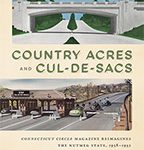






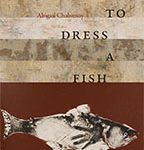
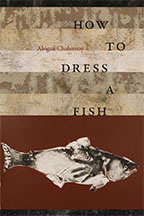 In How to Dress a Fish, poet Abigail Chabitnoy, of Unangan and Sugpiaq descent, addresses the lives disrupted by US Indian boarding school policy. She pays particular attention to the life story of her great grandfather, Michael, who was taken from the Baptist Orphanage, Wood Island, Alaska, and sent to Carlisle Indian Industrial School in Pennsylvania. Incorporating extracts from Michael’s boarding school records and early Russian ethnologies—while engaging Alutiiq language, storytelling motifs, and traditional practices—the poems form an act of witness and reclamation. In uncovering her own family records, Chabitnoy works against the attempted erasure, finding that while legislation such as the Alaska Native Claims Settlement Act reconnects her to community, through blood and paper, it could not restore the personal relationships that had already been severed.
In How to Dress a Fish, poet Abigail Chabitnoy, of Unangan and Sugpiaq descent, addresses the lives disrupted by US Indian boarding school policy. She pays particular attention to the life story of her great grandfather, Michael, who was taken from the Baptist Orphanage, Wood Island, Alaska, and sent to Carlisle Indian Industrial School in Pennsylvania. Incorporating extracts from Michael’s boarding school records and early Russian ethnologies—while engaging Alutiiq language, storytelling motifs, and traditional practices—the poems form an act of witness and reclamation. In uncovering her own family records, Chabitnoy works against the attempted erasure, finding that while legislation such as the Alaska Native Claims Settlement Act reconnects her to community, through blood and paper, it could not restore the personal relationships that had already been severed.